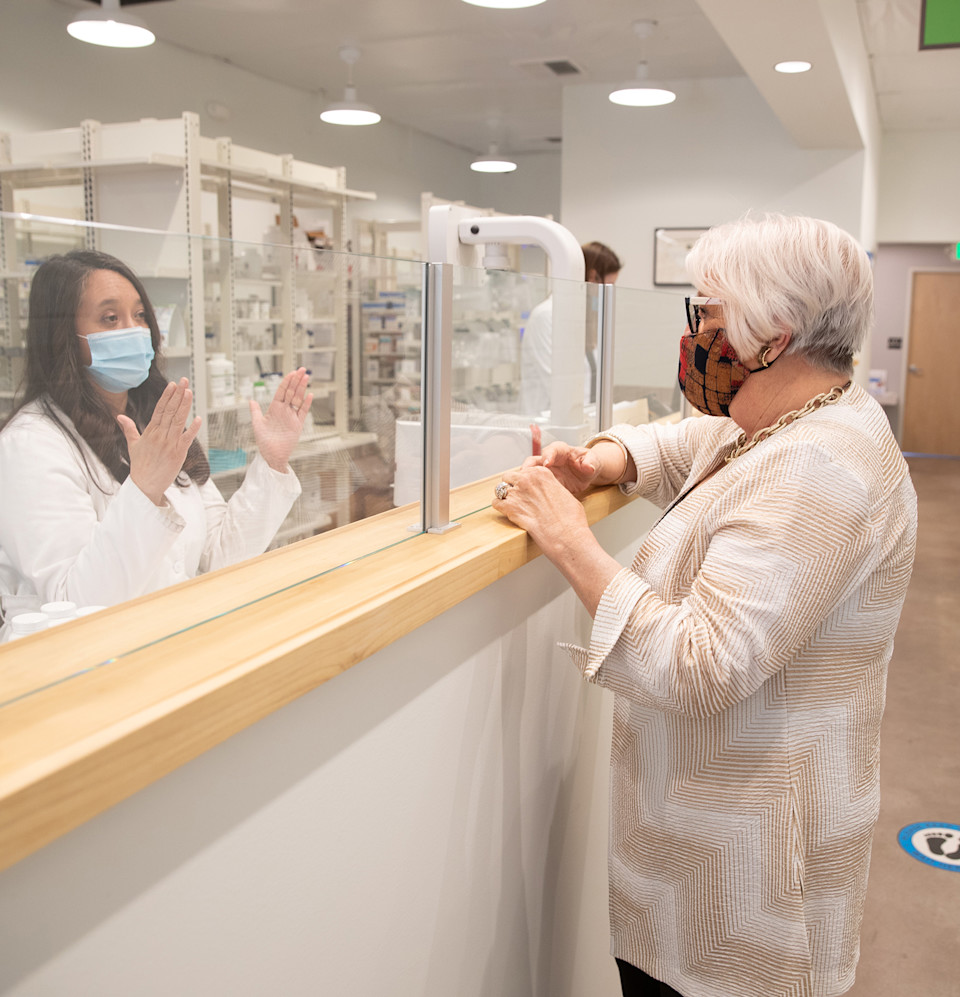
Joan Werblun, RN, dedicated her career to improving healthcare for diabetes patients. Now retired, she continues to advocate for improved patient affordability and access to medications they need.

Joan Werblun, RN, dedicated her career to improving healthcare for diabetes patients. Now retired, she continues to advocate for improved patient affordability and access to medications they need.
In this digital version of the 2021 Medication Access Report: Legislative and Regulatory Edition, we spoke with legislators and lobbyists helping shape policies to improve medication access, affordability and adherence.
For a full look at recent and upcoming legislation, download the 2021 Medication Access Report: Legislative and Regulatory Edition.
If you have diabetes, you want Joan Werblun as your nurse.
She began her nursing career at a Pennsylvania hospital where the medical director was a founder of the American Diabetes Association. Heavily influenced by his teaching, she brought her expertise to the newly opened UC Davis Medical Center in 1970.
“I became the diabetes nurse for the university,” Joan said. “They were just starting the medical school — they hadn’t even graduated their first class.”

Joan spent 37 years as a diabetes nurse, developing California's treatment and education standards to address broader patient access issues such as health literacy and social determinants of health.
During her 37 years at UC Davis, she also served on local, state and national boards and committees of the American Diabetes Association. Because of her extensive experience in caring for diabetes patients, the state asked her to head a diabetes care standards task force that eventually became the California Diabetes Coalition. She developed education programs for patients and families and taught classes for medical students, residents, nursing school students and even classes for the blind society in Sacramento.
She tried to retire once. But she’d forgotten about a grant she’d applied for months earlier.
“I had retired about two weeks when I got a call from the university saying your grant came through,” she said, laughing. “So, off I went.”
Joan’s grant funded a diabetes prevention and treatment program for 400 migrant laborers in Southern California’s almond farms. Medical care for this population is sparse, as the farms where they’re working are often hours away from provider’s offices and pharmacies.

As part of a grant program, Joan helped manage diabetes in migrant workers who had no other care option. Many sacrificed a day's wages to pick up insulin at the nearest pharmacy over two hours away.
For workers who needed insulin to help treat their diabetes once diagnosed, the cost and effort to obtain the prescription was nearly prohibitive. Families pooled money for the drug itself and gave up a day’s wages to drive to the nearest pharmacy. Some workers would cut their doses in half to stretch out the prescription. Because of this, they would end up sick and unable to work, further exacerbating the problem.
This problem is not isolated to California almond farm workers.
“It’s not just migrant laborers that have this problem,” Joan said. “A lot of people have to take a day off to go to the doctor — they can’t be taking days off to go to the pharmacist (too).”
It’s an issue California Assemblymember Adrin Nazarian (D-Van Nuys) is working to address. Nazarian has championed several policies over the last few years specifically to improve access to affordable healthcare in the state, including step therapy reform and lowering insulin copays.
“It’s critical to create a level playing field so people have a safety net,” Nazarian said. “They can take their next steps in life with a certain level of confidence and aren’t constantly worried about the bottom falling out.”
Various advocates across the country, including legislators, lobbyists and healthcare workers themselves, are working tirelessly to change the story of patient medication access in the United States.
--

Asm. Adrin Nazarian is introducing groundbreaking legislation in California that would improve price transparency at the point of prescribing.
In a recent survey, over 40 percent of patients said they skipped or reduced doses to stretch out their prescription, potentially putting their health at risk.CoverMyMeds Patient Survey, 2020
Joan recalled the many patients she’s known in her career who have sacrificed time and wages to visit their doctor to address a medical problem and get a prescription. When they reached the pharmacy counter and found out the cost, they often couldn’t afford it — at least, not right away. Some wait for their next paycheck. Others ask family members for money. Some work with their pharmacist to switch to a cheaper medication, but this process takes time, with callbacks to and from the physician’s office.
In the meantime, the patient’s condition goes unmanaged. Medication nonadherence can account for up to 25 percent of hospitalizations each year in the United States.Medication Adherence: The Elephant in the Room, U.S. Pharmacist, 2018 Providers can help reduce patient sticker shock at the pharmacy if they have access to real-time pricing and benefit information at the point of prescribing. While the technology for this capability exists, the data isn’t always available.
Upcoming federal and state legislation puts healthcare data and transparency at the forefront. What follows is a look at the most impactful measures pending before lawmakers.
For a full look at recent and upcoming legislation, download the 2021 Medication Access Report: Legislative and Regulatory Edition.


Improved interoperability and data liquidity policies can improve patient access to their electronic health data from almost anywhere on their choice of device.
The new administration's number one healthcare priority in 2021 will be the COVID-19 public health emergency. But such a far-reaching crisis has the potential to create policies that shape a more accessible, interoperable national healthcare framework moving forward.
The Final Rule requires clinical data to be exchanged through Fast Healthcare Interoperability Resources, or FHIR, developed by standards organization HL7 International. FHIR provides a formalized way to exchange health information among technologies. This standardization opens up healthcare IT innovation by having APIs speak the same language. FHIR provides standards for both information content and transport.
Open APIs, required through the Final Rule, running on FHIR, will allow hospitals, providers and health systems to enter and exchange data among apps and EHRs that best suit them. It also relieves burden on providers. Of providers with patients on complex therapies, 55 percent said electronic communication to other healthcare parties would exist in their ideal tool.CoverMyMeds Provider Survey, 2020
Providers will also have the freedom to switch EHRs without worrying about losing crucial data such as clinical notes. Technology will likely also be more user friendly with consistently named data fields and familiar interfaces. This can reduce onboarding and training time when introducing new tools and improve the user experience, a contributing factor to provider burnout. Seventy percent of physicians in one study reported stress related to marginal time for documentation, excessive EHR use and dissatisfaction with health IT technology.Nearly 70% of Physicians Suffering Stress Related to Health IT Use, EHR Intelligence, 2018
Patients, the center of the Final Rule, will be able to request and access their electronic health information on demand through portals and smartphone apps, no matter their provider, plan or healthcare system. This creates portable patient health data, expanding upon HIPAA to allow data liquidity, except in certain situations. The hope is this will also improve continuity of care by lightening the information sharing burden from patients, especially those who visit multiple specialists, a primary care provider and specialty pharmacies.

Upcoming legislation and regulations aim to push interoperable, nimble healthcare technology systems - so providers and pharmacists can have more productive conversations with patients.
The Centers for Medicare and Medicaid Service’s Medicare Advantage Part D Final Rule was finalized in 2020. The rule dictates Medicare Part D plans must allow enrollees to access patient-specific, real-time formulary and benefit information, including drug cost, alternatives and utilization management requirements.
Plans can use existing patient portals, develop new portals or use a computer application to fulfill this requirement. Plans will also provide real-time information to enrollees who call the plans’ customer service center. This requirement goes into effect for relevant plans Jan. 1, 2023, though many plans may implement this earlier with prescription decision support tools readily available.
For more on this final rule, as well as others, read the 2021 Medication Access Report: Legislative and Regulatory Edition.

As a pharmacist, Asm. John McDonald started including benefit and out-of-pocket cost on prescription labels 30 years ago. His bill in New York could help provide this information during prescribing.
At the state level, price transparency is key, as legislators aim to keep patient affordability and access paramount. Last year, two in three patients found out a medication costs more than expected when they got to the pharmacy.CoverMyMeds Patient Survey, 2020 As a result, more than one in three left without it.CoverMyMeds Patient Survey, 2020 Having benefit and cost information available in real time at the point of prescribing can be critical to patient medication adherence. And widening scope of practice for pharmacists can improve the patient experience once they arrive to pick up medication.
Prescription price transparency is an issue John McDonald has been working on for nearly thirty years. When he first started his career as a pharmacist, McDonald, an Assemblymember for New York’s 108th District, changed his pharmacy’s labels to include the cost of the medication — including the patient’s copay and the total drug cost.
“I go by a very simple adage: the right prescription for the right patient at the right price,” McDonald said. “We all benefit when the consumer has an understanding of the value of what they’re receiving.”
The Assemblymember is introducing a bill in New York that calls for more patient-specific real-time price transparency data at the point of prescribing. McDonald stressed the bill could help providers and, in turn, pharmacists like himself.
“If (a prescription) is not affordable, providers can address it before they leave the visit. That’s critical,” he said. “For the pharmacist, this should lead to a significant reduction in PAs in many circumstances. It (could) also lead to greater success on fulfillment of prescriptions.”

State Sen. Shane Reeves (R - Bedford) brings his experience in healthcare to the Tenneessee capitol building as he pushes for patient choice and price transparency in a recently introduced bill.
Real-time price transparency is also policy priority for California this year. Asm. Nazarian introduced the Patient Choice and Transparency Act (AB 752) in February 2021. This measure would require commercial payers and pharmacy benefit managers (PBM) in California to provide patient eligibility information to prescribers in real-time, delivered in industry-accepted standards.
Tennessee is following suit. State Sen. Shane Reeves (R-Bedford) is carrying a similar price transparency bill, with healthcare industry experience behind him. His family has been in the pharmacy industry for 120 years. As a pharmacist, Reeves said he looks for three things in healthcare policy: quality, access and choice for the patient.
“The transparency part of the bill, I think it could change the way people shop for their pharmaceutical needs,” Reeves said. “Transparency is an essential leg of the stool in creating a free market approach in healthcare and pharmacy in the country.”
These policies could open pathways for more patient-facing tools to improve choice and access both in the provider’s office and remotely. Incoming interoperability measures, such as those outlined in the ONC 21st Century Cures Act Final Rule, lay the path for improved data liquidity throughout the healthcare ecosystem, while maintaining patient privacy.
As a former healthcare worker, Joan recognized what these policies could mean for the patient-provider relationship.
“That way the patient knows right then and there, sitting with the doctor, what their copay is going to be … so when the patient leaves, they know what they’re in for,” Joan said.
Nazarian was quick to mention patients with socioeconomic challenges like the migrant laborers Joan worked with. The California bill has the potential to save patients valuable time and money by presenting all available options during the appointment.
“This is one of those unique circumstances where I think a lot of folks are on the same side of the issue,” Nazarian said. “It all around helps … everyone to be armed with the same information. And I think that will go a long way in also helping the system flow better.”
Even with a financial plan in place, patients can still find surprises at the pharmacy counter.
Read more on state-by-state prescription price transparency legislation in the full 2021 Medication Access Report: Legislative and Regulatory Edition.

Many patients discover their medication costs more than expected at the pharmacy. Over a third abandon the prescription. Surprises could be avoided with cost and benefit details during an appointment.
As many as one in five brand prescriptions filled through commercial plans were purchased using a copay assistance coupon from the drug manufacturer.A Perspective on Prescription Drug Copayment Coupons, USC Schaeffer, 2018 These copay cards, or coupons, provide patients payment assistance on their out-of-pocket drug costs, often up to a certain amount per year.
Starting in 2018, many payers and PBMs established copay accumulator adjustment programs (CAAPs). These programs prevent the value of a manufacturer copay card from being used toward a patient’s deductible or out-of-pocket maximum.Copay Accumulator Adjustment Programs, Institute for Patient Access, 2018
CAAPs can put a particular financial strain on patients with high deductible plans, accounting for nearly half of those under 65 on employee plans and 90 percent of those insured through the Affordable Care Act marketplace.Health Insurance Coverage: Early Release of Estimates from the National Health Interview Survey, January-September 2018, National Center for Health Statistics, 2019,Health Insurance Exchanges 2020 Open Enrollment Report, Centers for Medicare & Medicaid Services, 2020 If a patient with a CAAP plan chooses to use a copay card, they risk paying the full cost of the medication later in the year, as many copay cards have a maximum amount or use limit.
During the copay card use period, their prescription costs would not be applied to their deductible, leading to additional out-of-pocket expenses. In a 2018 study, the average copay card value per claim was $229.Prescription Drug Coupon Study, Commonwealth of Massachusetts Health Policy Commission, 2020 At this cost, nearly 50 percent of patients are likely to abandon these prescriptions.Medicine Spending and Affordability in the U.S., IQVIA, 2020

With more patients trusting their pharmacist with medication and care questions, healthcare policy can help pharmacists be more active parts of the patient care team.

Arizona, Illinois, Virginia, West Virginia and Georgia have passed laws restricting CAAPs to varying degrees. Twelve more states introduced CAAP bills that died in 2020 sessions; most of those measures have already been reintroduced this year.Copay Accumulator Q&A, Chronic Care Policy Alliance, 2020
With CAAPs still relatively new to the market, healthcare solutions that surface benefit details can help patients prepare for out-of-pocket costs they may encounter. As more states address the ability for manufacturer coupons to be applied to patient’s deductible and out-of-pocket max, point-of-prescribing technology that includes manufacturer discounts can improve patient price transparency.
This would be especially helpful at the pharmacy, where most medication affordability conversations take place. In turn, pharmacists can better serve as part of the patient care team.
To read more about legislation affecting the pharmacy, including scope of practice, read the 2021 Medication Access Report: Legislative and Regulatory Edition.

Julie Griffin, vice president of government affairs at the Tennessee Medical Association, recently faced medication access challenges following a procedure.
Barriers to medication access exist beyond affordability.
Julie Griffin is the vice president of government affairs at the Tennessee Medical Association, where she lobbies for change on behalf of providers in the state. She also suffers from chronic back pain that’s required a few surgeries. Before her most recent procedure in 2020, her provider wrote her a prescription for the weeks leading up to surgery to help her sleep comfortably.
After her three-hour surgery, her provider wrote a post-operative prescription. When she went to pick up the prescription, she was told her insurance wouldn’t cover it due to a refill-too-soon policy that limited the amount of the drug she could be prescribed within 30 days. So, Julie paid out-of-pocket for the prescription.
“Some people wouldn’t have been able to do that,” Julie said. “I’m just fortunate enough that I could.”

Prescription transparency for access barriers like PA can be improved with technology that helps surface these requirements at the point of prescribing.
But the worst was ahead for Julie, who developed an infection after her surgery, requiring two additional procedures and recovery from sepsis. When she finally left the hospital over 30 days after her initial surgery, she again visited the pharmacy to pick up her post-operative prescription.
Again, she was told her insurance wouldn’t cover the prescription. This time, because the dosage of the medication exceeded the amount the policy would cover. Again, she paid out of pocket for her prescription. Later, through phone calls to her provider and insurance company, she discovered her insurance would have covered the prescription had her provider submitted a prior authorization (PA).
“If this had been in my doctor’s (EHR), and they could have looked down and seen this much is going to require a prior authorization (PA), there’s no question I would have been able to get a PA (approved) based on what I’d gone through,” Julie said.

By surfacing benefit and price details early, patients like Julie don't have to do their own research on understanding what they'll pay for medications - so they can get back to living healthy lives.
Only 17 percent of providers surveyed start PA requests at the point of prescribing when an EHR notifies them of PA likelihood. Point-of-prescribing technology can support prospective PA submissions, saving patients, providers and pharmacists time — and improving patient adherence. When providers submit PA requests prospectively, patients can get their medications an average of 13.2 days sooner compared to when PA requests are submitted after the pharmacy has notified the provider.CoverMyMeds data on file, 2019
When discussing medication adherence, Joan stressed she is very clear to avoid the word "noncompliant" as a synonym, as it can imply patients intentionally aren't taking their medication — which is often not the case.
“When you talk about people being compliant … very few people deliberately will not take their medicine,” Joan said. “But they go through all this trauma to get their (medications). It becomes such a negative impulse.”
Legislation and incoming regulatory standards will support electronic PA management in-workflow for providers. A CMS final rule to be implemented this year requires Part D drug plans to support the NCPDP SCRIPT standard version 2017071, under which prescribers will be able to see if a Part D-covered drug requires PA during the prescribing process.Medicare Program; Secure Electronic Prior Authorization For Medicare Part D, Federal Register, 2020

Data liquidity of improved benefit coverage will allow providers to more easily discuss not only affordability issues with patients but benefit processes as well. The more providers can stay in-workflow with electronic solutions, the more time they have for these conversations. Due to PA management, over one third of providers surveyed reported having less face-to-face interaction with patients.
“I believe transparency is the biggest problem with healthcare,” Julie said. “The average person should be able to understand and not have to read 20,000 pages of policy manuals to submit insurance, respond to insurance and get paid by insurance.”
Joan would agree, having also spent time observing many facets of the healthcare industry.
“The systems we operate within are the biggest barrier,” Joan said. “We created these systems. We can change them.”

Patients like Julie can take action by sharing their stories with legislators to support patient choice and transparency throughout the healthcare ecosystem.
While healthcare policy and rule mandates will help achieve a fully accessible and interoperable healthcare ecosystem, adoption takes time and can be variable, creating an implementation patchwork.
Upcoming policies can widen the path to medication access, but healthcare stakeholders shouldn't wait to take action on moving the industry forward. Patients can talk to their providers about details on cost and benefit transparency. This can create more provider awareness and demand for payer-provided information within their EHRs. Further, patients and providers can reach out to plans or employers who sponsor a health plan for access to patient-specific benefit and cost information.
Health systems can implement existing cutting-edge transparency solutions. Care team tools built with the patient in mind can provide price, treatment method and communication options. When providers use a prescription decision support solution, such as real-time prescription benefit, patients are 19 percent more adherent to picking up their medication.CoverMyMeds data on file, 2019
Those from all sides of the healthcare network can also reach out to state legislators and ask for change.
If your state has a bill proposed, contact your representative and senator and ask them to support the effort:
Press inquiries:
media@covermymeds.com
The Medication Access Report is developed in consultation with an advisory board of healthcare experts representing major organizations across the industry — each with unique perspectives, interests and opinions.